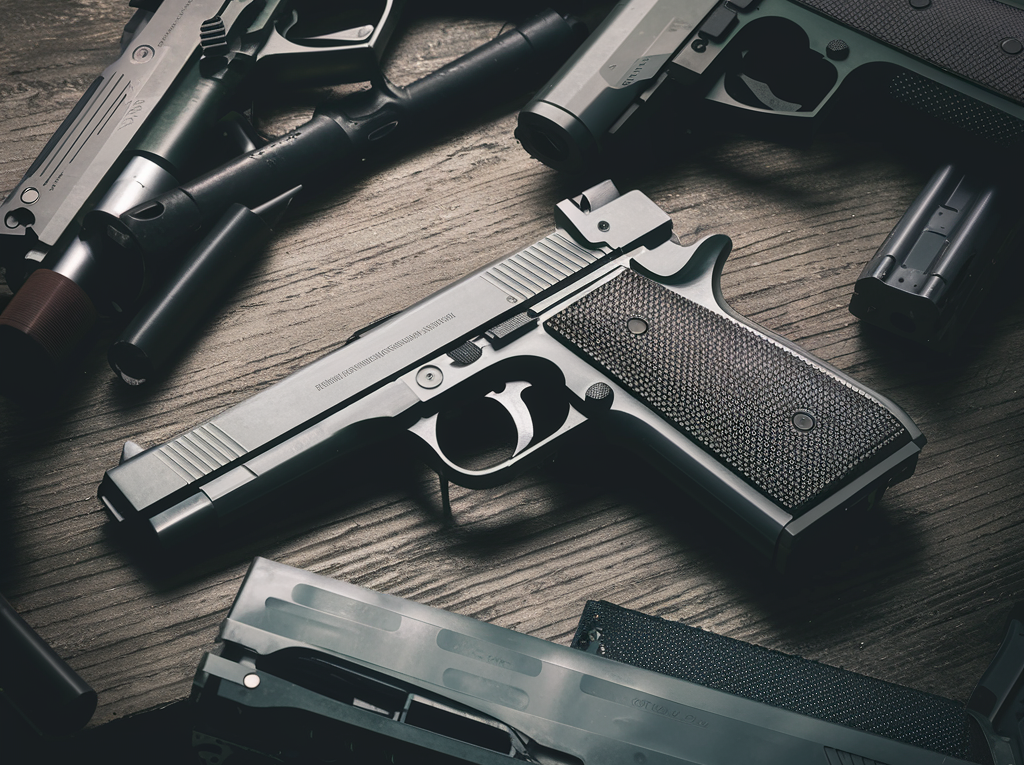Understanding the Impact of Firearms in Suicides: Promoting Safe Storage Practices and Risk Reduction Strategies
Understanding the Impact of Firearms in Suicides: Promoting Safe Storage Practices and Risk Reduction Strategies
Read Disclaimer
Learn about the comprehensive approach to suicide prevention, including access to mental health services, crisis intervention training, and community support networks. Discover how to support individuals and communities in promoting mental health and well-being.
Introduction:
Suicide is a pervasive and pressing public health issue that affects individuals, families, and communities worldwide. According to the World Health Organization (WHO), close to 800,000 people die by suicide every year, making it one of the leading causes of death globally. Within this complex landscape of suicide prevention, the role of firearms cannot be overlooked. Firearms, with their inherent lethality, pose a significant risk factor in suicide cases, often resulting in fatal outcomes with limited opportunities for intervention or rescue.
The lethality of firearms is a key aspect that distinguishes them from other suicide methods. Unlike many other means of self-harm or overdose, firearms have a high probability of causing immediate and irreversible harm. Statistics consistently show that suicide attempts involving firearms are more likely to be fatal than attempts using other methods. This heightened lethality underscores the urgent need to address the role of firearms in suicide prevention efforts.

Furthermore, the accessibility of firearms exacerbates the risk of suicide, particularly during moments of acute distress or crisis. Research indicates that individuals with access to firearms are at a significantly higher risk of dying by suicide compared to those without access. This heightened risk is attributed to the ease and immediacy with which firearms can be used to inflict fatal injuries. Unlike medication overdose or self-harm methods that may allow for intervention or medical assistance, firearm-related suicides often result in irreversible outcomes, leaving little chance for rescue.
Given the gravity of the situation, it is imperative to explore and understand the relationship between firearms and suicides comprehensively. This blog seeks to delve into this complex intersection, shedding light on the factors contributing to firearm-related suicides and highlighting effective strategies for prevention. In particular, the focus will be on promoting safe storage practices and implementing risk reduction strategies to mitigate the risk of firearm-related suicides.
By delving into this critical issue and advocating for evidence-based interventions, we aim to contribute to the ongoing dialogue on suicide prevention and firearm safety. Together, we can work towards creating safer communities where individuals at risk of suicide receive the support and resources they need to overcome crises and find hope for the future.
Exploring the Link Between Firearms and Suicides:
1. Lethality of Firearms : Firearms are widely recognized as one of the most lethal means of suicide. The high lethality of firearms stems from their ability to cause fatal injuries quickly and with minimal effort. Unlike other methods, such as medication overdose or self-harm, which may allow for interventions or medical treatments, firearm-related suicides often result in immediate and irreversible outcomes. The speed and efficiency with which firearms can cause fatal injuries leave little opportunity for individuals to reconsider their actions or for others to intervene effectively. Consequently, suicides involving firearms are more likely to result in death compared to attempts using other methods. This heightened lethality underscores the urgent need to address the accessibility and availability of firearms, particularly among individuals at risk of suicide.
2. Access to Firearms : Access to firearms plays a significant role in determining an individual’s risk of dying by suicide. Research consistently shows that individuals with access to firearms are at a heightened risk of suicide compared to those without access. This increased risk is particularly pronounced during moments of crisis or acute distress when individuals may be more vulnerable to impulsive actions. The availability of firearms in the home provides individuals with immediate access to a highly lethal means of self-harm, increasing the likelihood of fatal outcomes. Moreover, studies have found that restricting access to firearms, either through temporary removal or safe storage practices, can effectively reduce the incidence of firearm-related suicides. Therefore, efforts to address firearm access, such as implementing safe storage laws or promoting responsible firearm ownership, are crucial components of suicide prevention strategies.

3. Impulsivity in Suicide : Many suicide attempts are characterized by impulsivity, with individuals acting on overwhelming emotions or distress without careful consideration or planning. The presence of firearms in the home can exacerbate this impulsivity, as they offer an immediate and irreversible means of carrying out suicidal intentions. Unlike other methods that may require time or preparation, firearms provide individuals with a quick and efficient way to inflict fatal injuries upon themselves. This heightened impulsivity, coupled with the lethality of firearms, significantly increases the risk of fatal outcomes in suicide attempts. Recognizing the role of impulsivity in suicide is essential for developing targeted interventions aimed at reducing access to lethal means, promoting safe storage practices, and providing alternative coping strategies for individuals in crisis. By addressing impulsivity and restricting access to firearms, communities can effectively reduce the incidence of firearm-related suicides and save lives.
In summary, the link between firearms and suicides is complex and multifaceted, encompassing issues of lethality, access, and impulsivity. By understanding these factors and implementing evidence-based strategies to address them, communities can work towards preventing firearm-related suicides and promoting mental health and well-being for all individuals.
Implementing Safe Storage Practices and Risk Reduction Strategies:
1. Secure Firearm Storage : Safe storage practices play a critical role in preventing unauthorized access to firearms, particularly among individuals at risk of suicide, such as adolescents or those experiencing mental health crises. Keeping firearms securely locked in cabinets or gun safes helps restrict access and reduces the likelihood of impulsive use. Additionally, storing firearms in locked containers can prevent theft and unauthorized access, further enhancing safety within the household. By implementing secure firearm storage practices, individuals can create barriers to access, providing time for intervention and reducing the risk of impulsive suicide attempts.
2. Separating Firearms from Ammunition : In addition to secure storage, separating firearms from ammunition adds an extra layer of safety and reduces the likelihood of impulsive suicide attempts. Storing firearms and ammunition in separate locations within the home requires individuals to take deliberate action to access both components, increasing the time and effort required to carry out a suicidal act. This delay provides a critical window for intervention and may deter impulsive actions, potentially saving lives. Moreover, separating firearms from ammunition can prevent accidental shootings and unauthorized use by children or individuals unfamiliar with firearms, enhancing overall safety within the household.
3. Temporary Transfer of Firearms : During periods of heightened suicide risk or emotional distress, temporarily transferring firearms to a trusted friend, family member, or local law enforcement can help reduce immediate access to lethal means. This temporary transfer allows individuals in crisis to access support and assistance while minimizing the risk of impulsive suicide attempts. By entrusting firearms to responsible individuals or authorities, individuals can create a safer environment for themselves and others during times of vulnerability. Temporary firearm transfers serve as a proactive measure to prevent harm and provide individuals with the support they need to navigate through difficult times.

4. Firearm Safety Education : Educating firearm owners about the risks associated with firearms and the importance of safe storage practices is crucial for promoting responsible ownership and reducing the likelihood of firearm-related suicides. Firearm safety education programs can provide individuals with essential information on safe handling, storage, and usage of firearms, emphasizing the importance of securing firearms to prevent unauthorized access. Additionally, these programs can raise awareness about the warning signs of suicide and encourage individuals to seek help for themselves or others in crisis. By empowering firearm owners with knowledge and resources, firearm safety education promotes safer practices and contributes to suicide prevention efforts.
5. Community-Based Interventions : Community initiatives, such as firearm buyback programs or campaigns promoting safe storage practices, play a vital role in raising awareness and encouraging responsible firearm ownership. Firearm buyback programs provide individuals with an opportunity to voluntarily surrender firearms, reducing the number of firearms in circulation and minimizing access to lethal means. Additionally, campaigns promoting safe storage practices educate the community about the importance of securely storing firearms and provide resources for implementing safe storage solutions. By mobilizing community resources and fostering collaboration, these interventions create a supportive environment for suicide prevention and promote safer communities for all residents.
6. Legislative Measures : Policy interventions, such as implementing safe storage laws or waiting periods for firearm purchases, are essential for reducing access to firearms during periods of increased suicide risk. Safe storage laws require firearm owners to securely store firearms when not in use, reducing the risk of unauthorized access and preventing impulsive use. Waiting periods for firearm purchases introduce a delay between the decision to purchase a firearm and its acquisition, providing individuals with additional time to reconsider their decision and access support if needed. Additionally, background checks for firearm purchases help prevent individuals at risk of harming themselves or others from accessing firearms. By enacting legislative measures, policymakers can create safer environments and support suicide prevention efforts within communities.
Supporting Individuals and Communities:
1. Access to Mental Health Services : One of the fundamental pillars of suicide prevention is ensuring access to comprehensive mental health services for individuals in need. This includes timely access to mental health professionals, crisis intervention hotlines, counseling services, and psychiatric treatment facilities. By providing accessible and affordable mental health services, individuals struggling with suicidal ideation or mental health challenges can receive the support and treatment they need to address underlying issues and develop coping strategies. Moreover, expanding mental health services to underserved communities and marginalized populations is essential for promoting equity and reducing disparities in access to care. By investing in mental health infrastructure and resources, communities can create a supportive environment where individuals feel empowered to seek help and receive appropriate treatment for their mental health needs.
2. Crisis Intervention Training : Training healthcare professionals, law enforcement personnel, educators, and community members in suicide prevention and crisis intervention techniques is crucial for enhancing the community’s ability to identify individuals at risk and provide timely support and referral to services. Crisis intervention training programs, such as Mental Health First Aid or Applied Suicide Intervention Skills Training (ASIST), equip participants with the knowledge and skills to recognize warning signs of suicide, engage in empathetic communication, and connect individuals in crisis with appropriate resources and support. By increasing awareness and capacity for suicide prevention within the community, crisis intervention training programs contribute to early intervention and help save lives. Additionally, ongoing education and training opportunities ensure that individuals remain informed about best practices in suicide prevention and intervention, fostering a community-wide commitment to supporting mental health and well-being.
3. Community Support Networks : Building strong community support networks is essential for promoting resilience and reducing the risk of suicide. These networks provide individuals with a sense of belonging, social support, and connectedness, which are protective factors against suicidal behavior. Community support networks can take various forms, including peer support groups, community organizations, faith-based groups, and online support forums. By fostering connections among individuals with shared experiences or interests, community support networks create opportunities for mutual support, validation, and encouragement. Moreover, community-based initiatives, such as suicide prevention coalitions or grassroots advocacy groups, play a vital role in raising awareness, promoting education, and mobilizing resources to address suicide within the community. By harnessing the collective strength and resilience of the community, individuals and families affected by suicide can find comfort, solidarity, and hope for recovery.
In conclusion, supporting individuals and communities in suicide prevention requires a multifaceted approach that addresses underlying mental health needs, enhances crisis intervention capabilities, and fosters community support networks. By prioritizing access to mental health services, providing comprehensive training in suicide prevention and intervention, and building strong community connections, communities can create a supportive environment where individuals feel valued, heard, and empowered to seek help when needed. Together, we can work towards preventing suicide, promoting mental health, and supporting the well-being of all individuals and communities.
Conclusion:
In conclusion, supporting individuals and communities in suicide prevention is a multifaceted endeavor that requires a comprehensive approach. By addressing the underlying factors contributing to suicide risk, enhancing crisis intervention capabilities, and fostering strong community support networks, we can create a supportive environment where individuals feel empowered to seek help and receive the assistance they need. Access to mental health services, crisis intervention training, and community support networks are essential components of suicide prevention efforts. By working together to promote mental health awareness, reduce stigma, and build resilient communities, we can make significant strides in preventing suicide and supporting the well-being of all individuals and communities.
15 FAQs with Answers:
1. What are the warning signs of suicide?
– Warning signs of suicide may include talking about wanting to die, feelings of hopelessness or worthlessness, withdrawing from activities, and increased substance abuse.
2. How can I help someone who may be suicidal?
– You can help someone who may be suicidal by listening nonjudgmentally, expressing your concern, and encouraging them to seek professional help.
3. Are there specific risk factors for suicide?
– Yes, specific risk factors for suicide include mental illness, substance abuse, a history of trauma or abuse, access to lethal means, and a lack of social support.
4. What should I do if I suspect someone is suicidal?
– If you suspect someone is suicidal, take their concerns seriously, express your support, and encourage them to seek help from a mental health professional or crisis hotline.
5. What role do mental health services play in suicide prevention?
– Mental health services play a crucial role in suicide prevention by providing assessment, treatment, and support for individuals experiencing mental health challenges or suicidal ideation.
6. How effective are crisis intervention training programs?
– Crisis intervention training programs are highly effective in equipping individuals with the skills and knowledge needed to recognize warning signs of suicide and provide appropriate support and referral to services.
7. What are some examples of community support networks?
– Examples of community support networks include peer support groups, community organizations, faith-based groups, and online support forums.
8. How can I access mental health services if I can’t afford them?
– There are often low-cost or sliding-scale mental health services available through community clinics, nonprofit organizations, and government agencies. Additionally, many insurance plans offer coverage for mental health services.
9. Are there resources available for individuals experiencing a mental health crisis?
– Yes, there are resources available for individuals experiencing a mental health crisis, including crisis hotlines, mobile crisis teams, and emergency psychiatric services.
10. What should I do if I’m feeling suicidal?
– If you’re feeling suicidal, it’s important to reach out for help immediately. You can call a crisis hotline, talk to a trusted friend or family member, or seek help from a mental health professional.
11. How can I support someone who has lost a loved one to suicide?
– You can support someone who has lost a loved one to suicide by offering your presence, listening without judgment, and connecting them with support groups or counseling services.
12. Are there ways to reduce access to lethal means in the home?
– Yes, you can reduce access to lethal means in the home by securely storing firearms, locking up medications, and removing or securing other potentially harmful items.
13. What should I do if I find out someone has access to lethal means and is suicidal?
– If you find out someone has access to lethal means and is suicidal, it’s important to take immediate action to remove the means from their access and encourage them to seek help from a mental health professional or crisis hotline.
14. How can I get involved in suicide prevention efforts in my community?
– You can get involved in suicide prevention efforts in your community by volunteering with local organizations, participating in awareness events, and advocating for policies that support mental health and suicide prevention.
15. What are some signs that a community may need more suicide prevention resources?
– Signs that a community may need more suicide prevention resources include high rates of suicide, limited access to mental health services, and stigma surrounding mental illness and help-seeking behaviors.

Your point of view caught my eye and was very interesting. Thanks. I have a question for you.
Your point of view caught my eye and was very interesting. Thanks. I have a question for you.
Reading your article helped me a lot and I agree with you. But I still have some doubts, can you clarify for me? I’ll keep an eye out for your answers.
I don’t think the title of your article matches the content lol. Just kidding, mainly because I had some doubts after reading the article.
Your point of view caught my eye and was very interesting. Thanks. I have a question for you.
Can you be more specific about the content of your article? After reading it, I still have some doubts. Hope you can help me.
Can you be more specific about the content of your article? After reading it, I still have some doubts. Hope you can help me.
Your point of view caught my eye and was very interesting. Thanks. I have a question for you.
Your point of view caught my eye and was very interesting. Thanks. I have a question for you. https://accounts.binance.com/zh-CN/register?ref=VDVEQ78S
Your article helped me a lot, is there any more related content? Thanks!
Your point of view caught my eye and was very interesting. Thanks. I have a question for you.
Your article helped me a lot, is there any more related content? Thanks! https://www.binance.info/register?ref=P9L9FQKY
Your point of view caught my eye and was very interesting. Thanks. I have a question for you.
I don’t think the title of your article matches the content lol. Just kidding, mainly because I had some doubts after reading the article.
Can you be more specific about the content of your article? After reading it, I still have some doubts. Hope you can help me.
I don’t think the title of your article matches the content lol. Just kidding, mainly because I had some doubts after reading the article.
Can you be more specific about the content of your article? After reading it, I still have some doubts. Hope you can help me.
Your article helped me a lot, is there any more related content? Thanks!
I don’t think the title of your article matches the content lol. Just kidding, mainly because I had some doubts after reading the article.
Your point of view caught my eye and was very interesting. Thanks. I have a question for you.
Can you be more specific about the content of your article? After reading it, I still have some doubts. Hope you can help me.
Your point of view caught my eye and was very interesting. Thanks. I have a question for you. https://www.binance.com/sl/register?ref=GQ1JXNRE
I don’t think the title of your article matches the content lol. Just kidding, mainly because I had some doubts after reading the article. https://www.binance.info/en-NG/register?ref=YY80CKRN
paypal casinos online that accept
References:
http://www.annunciogratis.net/
mobile casino paypal
References:
https://justhired.co.in/employer/free-slots-with-bonus-by-gambino-social-casino
australian online casinos that accept paypal
References:
https://skillnaukri.com/
casino with paypal
References:
https://cybernetshell.com/employer/paypal-casinos-best-online-casinos-that-accept-paypal/
online betting with paypal winnersbet
References:
skilling-india.in
Mit der Einführung des Live Casinos kommt das Spielcasino
zu euch nach Hause. Eines der Hauptargumente für das Spielen im
landbasierten Spielcasino und gegen Online Casino Seiten war das Flair, das dort herrscht.
Es schränkt die Casino Setzlimits stark ein und das Angebot an Tischspiele wird ein anderes sein als bei den besten Online Casinos mit
EU-Lizenz. Das liegt vielleicht auch daran, dass durch das
neue Glücksspielgesetz die rechtliche Unsicherheit ein Ende hat und es deutsche Online Casino
Lizenzen gibt. Als deutscher Spieler hat man den Vorteil, dass Malta unter EU-Recht fällt und man in den Internet Casinos rechtlich geschützt ist.
Der RTP gibt an, wie viel Prozent der Einsätze
der Glücksspielanbieter wieder an den Kunden ausschüttet.
Auf diese Weise können Spieler sich sicher sein,
dass die Auszahlungsquote für Slots oder Tischspiele wie Roulette den Tatsachen entsprechen.
Das Logo der vorhandenen Glücksspiellizenz befindet sich in der Regel im Footer
der ausgewählten Online Casino Webseite. Die Anmeldung in Online Casinos
mit EU-Lizenz ist deutschlandweit verboten. Die
deutsche Lizenz legt einen großen Fokus
auf den Spielerschutz. Während eine gültige Lizenz essenziell für die Seriosität eines
Online Casino Angebots ist, muss ein Online Spielcasino noch weitere Kriterien erfüllen,
um von uns empfohlen zu werden.
References:
https://onlinegamblingcasino.s3.amazonaws.com/mgm grand hotel & casino las vegas nevada.html
Anhand strenger Bewertungskriterien stellen unsere Autoren sicher, dass wir Ihnen nur die besten Online-Casinos
für Österreich empfehlen. Sie bieten Tools für den Selbstausschluss vom Online-Glücksspiel und Programme zur Suchtprävention an. Sie überwacht die lizenzierten Online-Casino-Betreiber
und stellt sicher, dass die vom BMF festgelegten Vorschriften eingehalten werden.
Die Welt der Online Casinos in Österreich bietet eine beeindruckende
Vielfalt an Spielen, die jeden Geschmack treffen.
Wenn Sie das beste Online Casino in Österreich für sich
definiert haben, schauen Sie sich unsere Schritt-für-Schritt-Anleitung an. Wir veröffentlichen nur Boni mit klaren und fairen Bedingungen, die österreichischen Spielern echten Mehrwert bieten. Entdecken Sie die besten Optionen, die
perfekt zu Ihnen passen. In der vielfältigen Welt der Online Casinos in Österreich finden Sie unterschiedliche Kategorien, die auf verschiedene Spielertypen und Vorlieben zugeschnitten sind.
Unser Expertenteam bewertet die besten Online Casinos für Österreich im Vergleich basierend auf einer Vielzahl von Kriterien. 22bet ist
die beste Wahl für Spieler, die nach niedrigen Einzahlungslimits suchen,
da Einzahlungen bereits ab 1 € in 11 Kryptowährungen und Mindesteinzahlungen von 10 € in Fiat-Währungen möglich sind.
References:
https://s3.amazonaws.com/onlinegamblingcasino/online casino casino game.html
Visit Site – Layout is crisp, browsing is easy, and content feels trustworthy and clear.